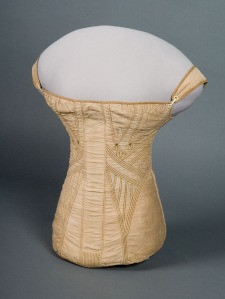
Woman’s Corset, 1810-1820s
Smithsonian Museum of National History, Gifts of Frederic A. Delano, Dr. and Mrs. Arthur M. Greenwood, and the Belcher Family
The corset has been a controversial fashion piece since its inception with those who argue for it being a torture device and antagonistic toward women. Its ability to accentuate the waist corresponds to ideas of power and control, however Steele offers a different perspective on the corset. She advocates for its positive connotations linked with social status, respectability and self-discipline. Both sides are applicable to sea wives, or “Cap Horn Widows.” With their husbands off at sea, wives were able to shape their life and home both economically and socially. The corset opposed their independent lifestyle by controlling them to conform to Victorian ideals of domesticity. This power and influence of the corset to make women appear a particular could be viewed as demeaning. On the other hand, notions of domesticity during the time called for a sexually appealing wife and a strong, nuclear family.[i]
Women were still able to perform work while wearing the whaleboned bodies and a slender waist was associated with a higher social standing. The intimate curves that whalebone produced for the body corresponded to the sexual allure of Victorian domesticity. Domestic notions sought for women’s work to be limited to the private home and the male’s work to the public sector. Women were to oversee the household and maintain a strong family unit.
[i] Norling, Lisa. Captain Ahab Had a Wife, 170.

